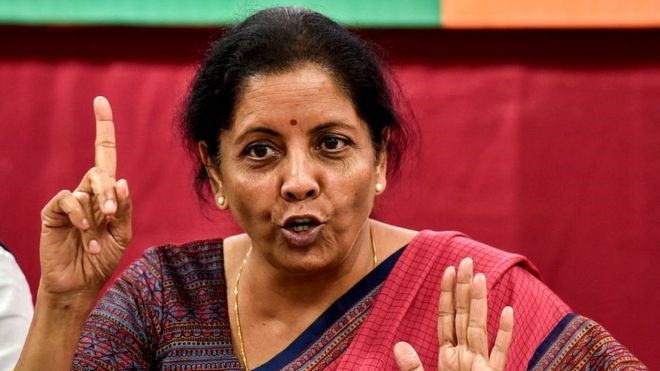What is GDP and why is it important for the general public?
On Monday, the government will release the GDP figures for the April-June quarter in the current financial year.
For the past few years, India’s economy has been in a state of lethargy, but these figures of the last quarter may be the worst figures of the past few decades.
This is because during April to June this year, lockdown was implemented across the country to prevent the spread of corona virus. Except for the supply of food and essential commodities, all other economic activities are stagnating during this period.
The coming GDP figures are important for everyone, as this will be the first official acknowledgment of the slowdown in the economy immediately after the outbreak of the Kovid-19 epidemic in India.
So first of all let’s understand what the GDP figures are.
What is GDP?
Gross domestic product (GDP) is the total value of all goods and services produced in the country in a given year.
Economist Sushant Hegde of Research and Ratings firm care ratings says that GDP is just like ‘a student’s marksheet’.
The way the marksheet shows how the student has performed throughout the year and in which subjects he has been strong or weak. In the same way, GDP shows the level of economic activity and it shows which sectors have led to the rise or fall.
This shows how well or poorly the economy has performed in a year. If GDP data shows sluggishness, it means that the country’s economy is slowing down and the country did not produce enough goods as compared to last year and the service sector is also declining.
The Central Statistics Office (CSO) in India assesses GDP four times a year. That is, GDP is assessed every quarter. Every year it releases annual GDP growth figures.
It is believed that for a low and medium income country like India, it is necessary to achieve higher GDP growth year after year to meet the needs of the country’s growing population.
GDP shows the economic growth and development of the country in a fixed period.
How is it assessed?
GDP is measured through four important components.
The first component is consumption expenditure. It refers to the total expenditure of the people for purchasing goods and services.
Second, ‘Government expenditure’ is the third ‘investment expenditure’ and finally comes net exports.
GDP is assessed in nominal and real terms. In nominal terms it is the value of all goods and services at current prices.
When it is adjusted against inflation in relation to a base year, we get real GDP. We usually consider real GDP as the growth of the economy.
Data of GDP is gathered from eight sectors. These include agriculture, manufacturing, electricity, gas supply, mining, quarrying, forestry and fisheries, hotels, construction, trade and communication, financing, real estate and insurance, business services and community, social and public services.
Why is this important for the general public?
This is important for the general public because it proves to be an important factor for the government and the people to decide.
If GDP is increasing, it means that the country is doing well in terms of economic activities and government policies are proving effective at the ground level and the country is moving in the right direction.
If GDP is getting sluggish or going into the negative realm, it means that the government needs to work on its policies to help bring the economy back on track.
Apart from the government, traders, stock market investors and different policy makers use the GDP data to make the right decisions.
When the economy performs well, businessmen invest more money and increase production because they are optimistic about the future.
But when GDP figures are weak, everyone starts saving their money. People spend less money and invest less. This leads to further economic growth.
In such a situation, the government is expected to spend more money. The government gives more money to businesses and people through different schemes so that they spend money in exchange for it and in this way can promote economic growth.
Similarly, policymakers use GDP data to formulate policies to help the economy. It is used as a scale to make future plans.
GDP is still not the whole picture
However, several sectors are covered in GDP to assess the growth of the economy. But it still does not cover everything.
Experts believe that the GDP data does not reveal the status of the unorganized sector.
Senior economist professor Arun Kumar says, “GDP data does not include the unorganized sector which accounts for 94 percent of the country’s employment.”
Says Arun Kumar, “If GDP falls in the negative realm, it means that the performance of the unorganized sector is worse than that of the organized sector.”
In such a situation, if the GDP growth is close to 10 to 15 percent, then it means that the growth of the unorganized sector is 20 to 30 The percentage will be between.
Simply put, the GDP data shows how the organized sector performs, but it completely ignores the unorganized sector, which comprises the country’s poor population.
Many agencies and experts are saying that the Indian economy may weaken by four to 15 percent in 2021-22.
Reserve Bank of India Governor Shaktikanta Das has said that the Indian economy will go into negative territory. However, the RBI has not said how much the GDP will fall.
The thing to keep in mind is that the Indian economy has been languishing for the past four years.
In the year 2016-17, GDP grew by 8.3%. After this, growth was seven percent in 2017-18. It fell to 6.1 percent in 2018-19 and to 4.2 percent in 2019-20.
A McKinsey report said, “The Kovid crisis has exacerbated this challenge. In the absence of immediate steps to boost growth, income and quality of life in India may reach a decade of stagnation.”
The Kovid epidemic has made the situation worse and economists say that it may take more time for India to recover against other Asian countries.




